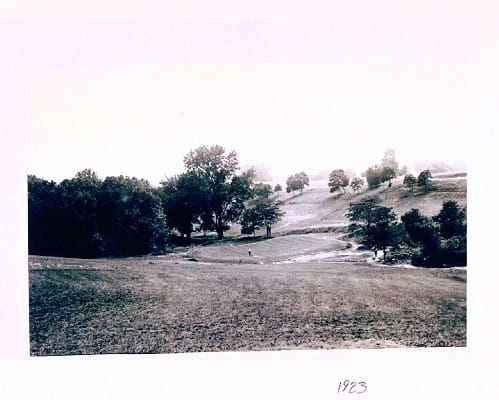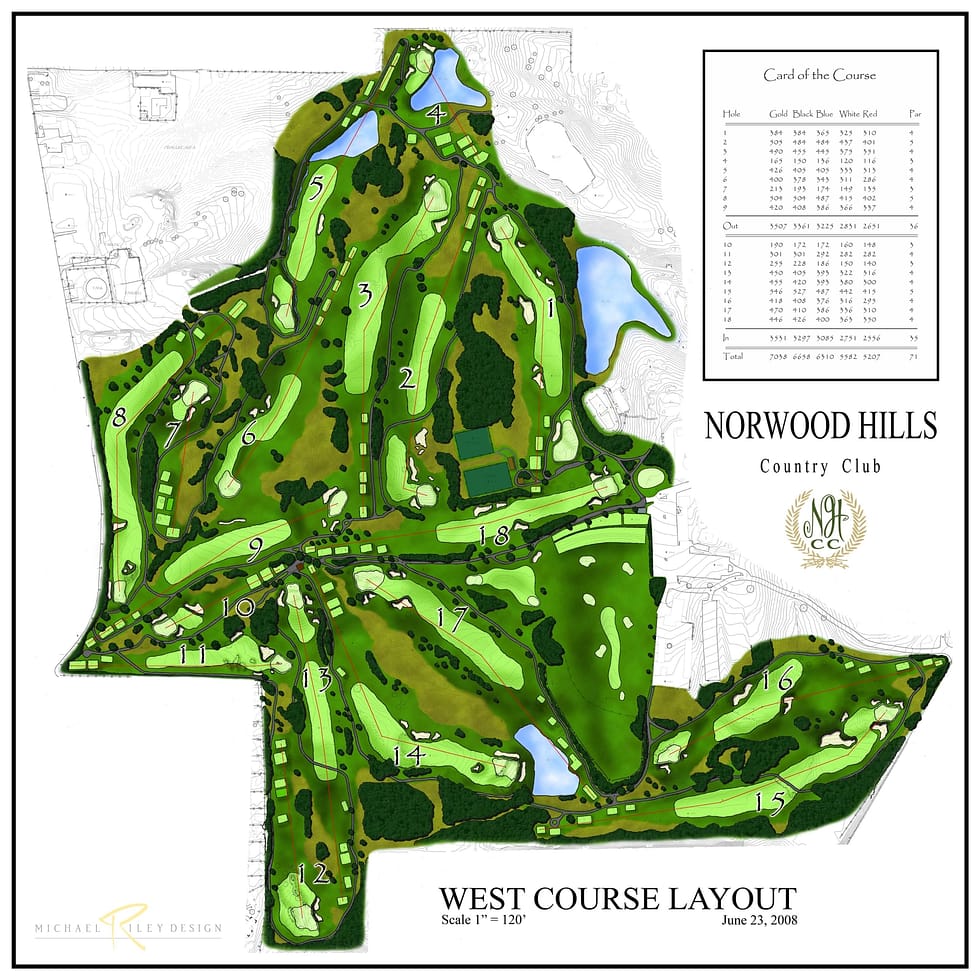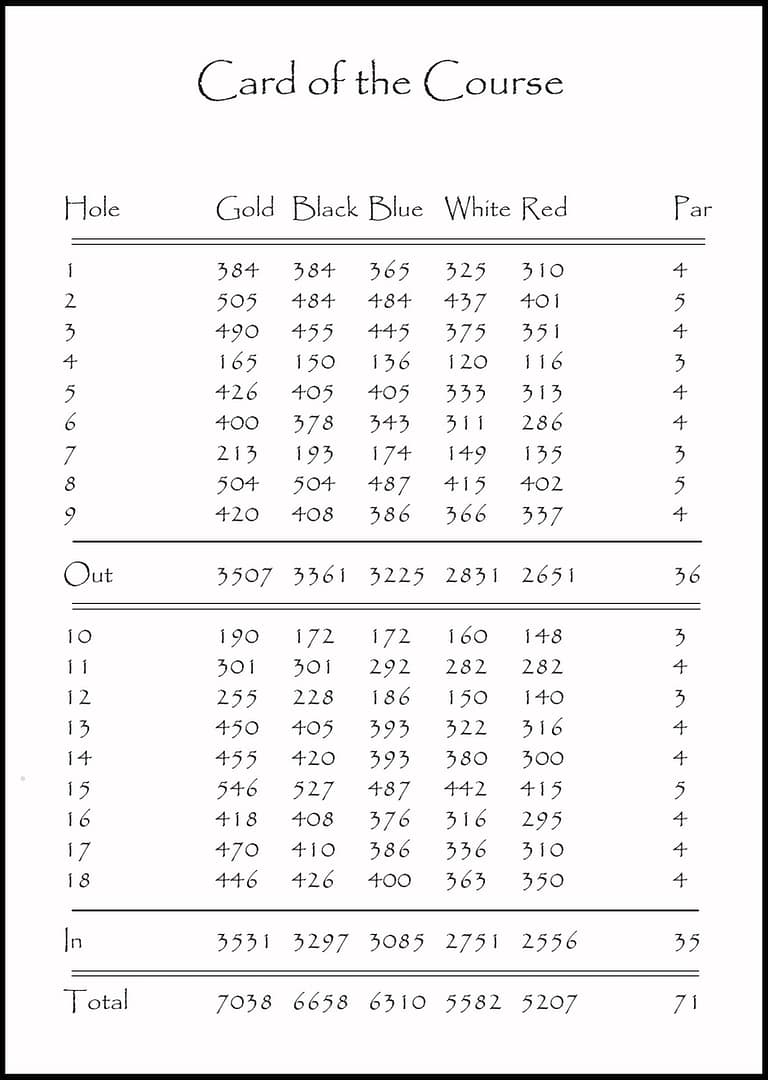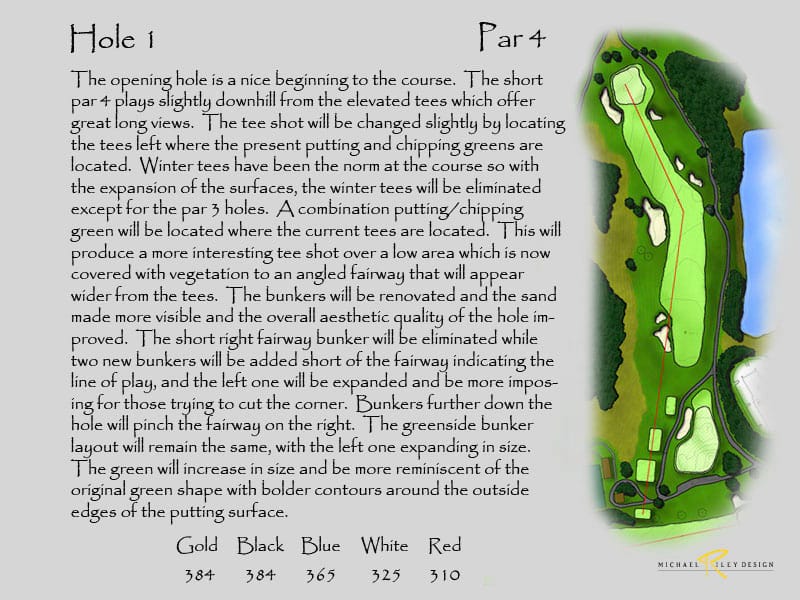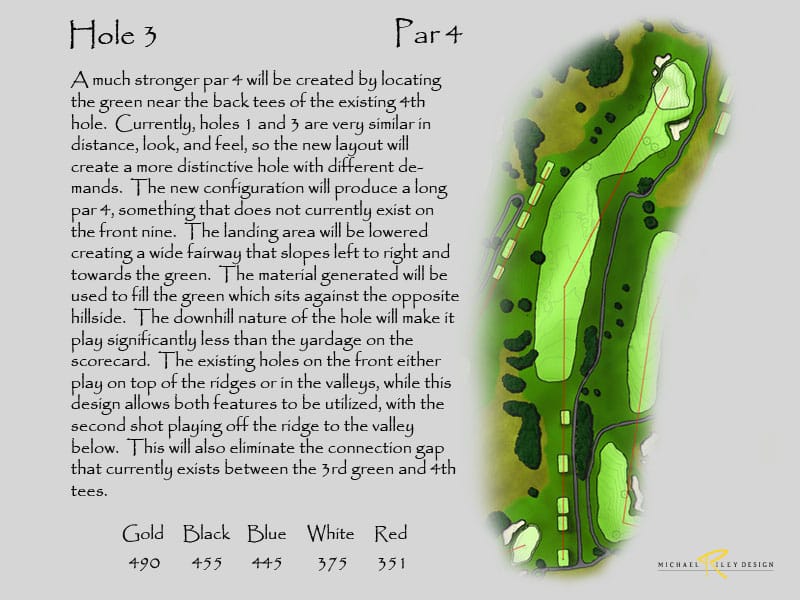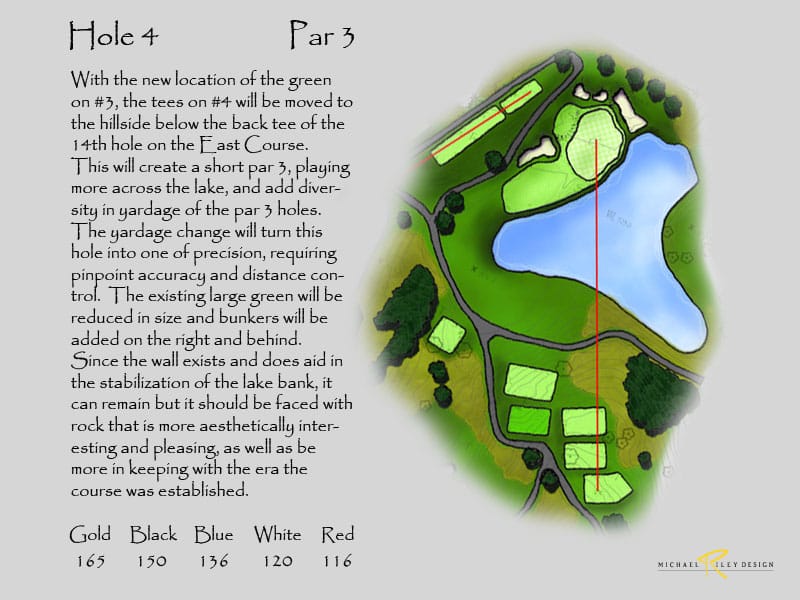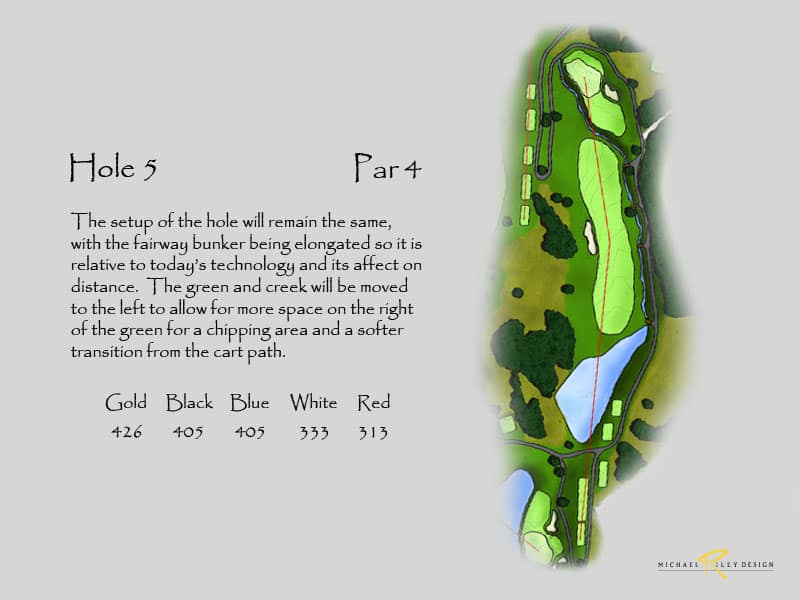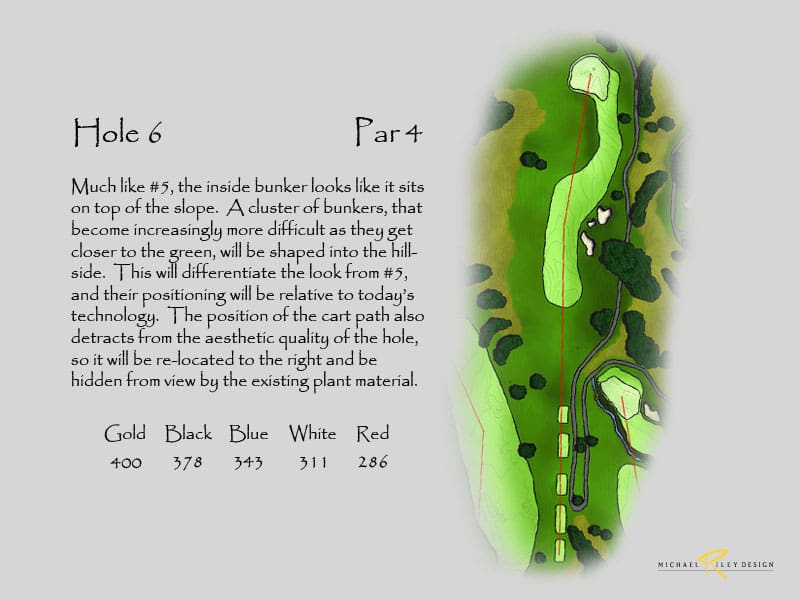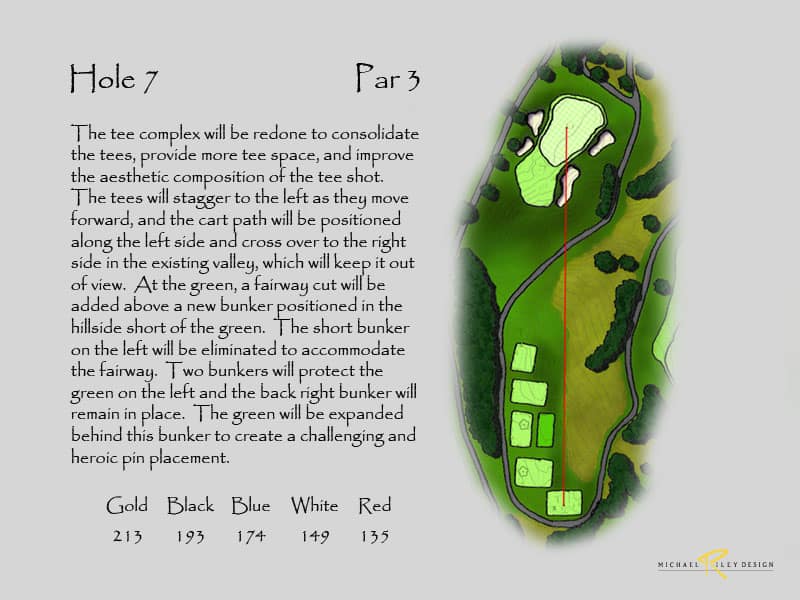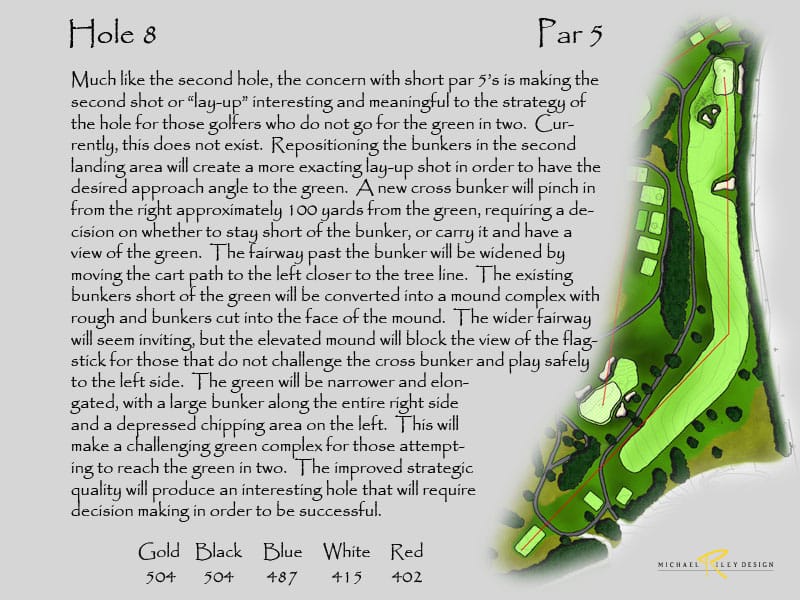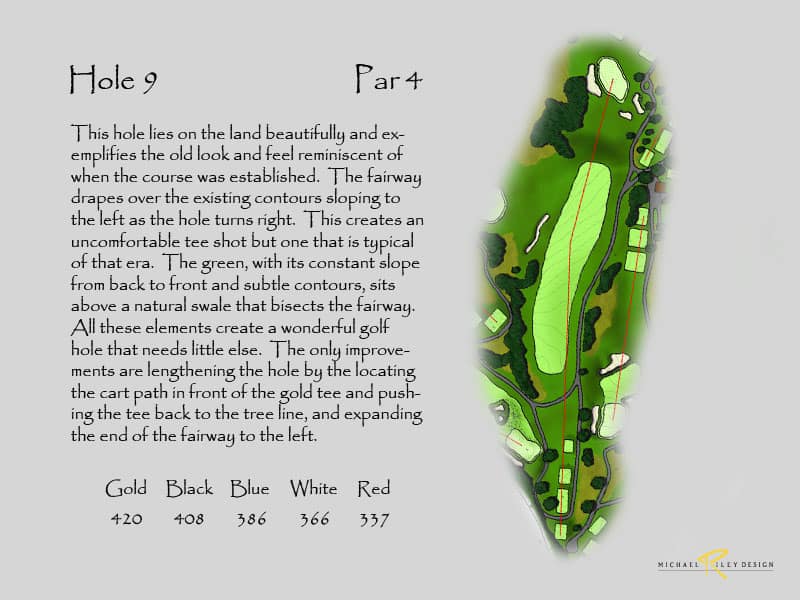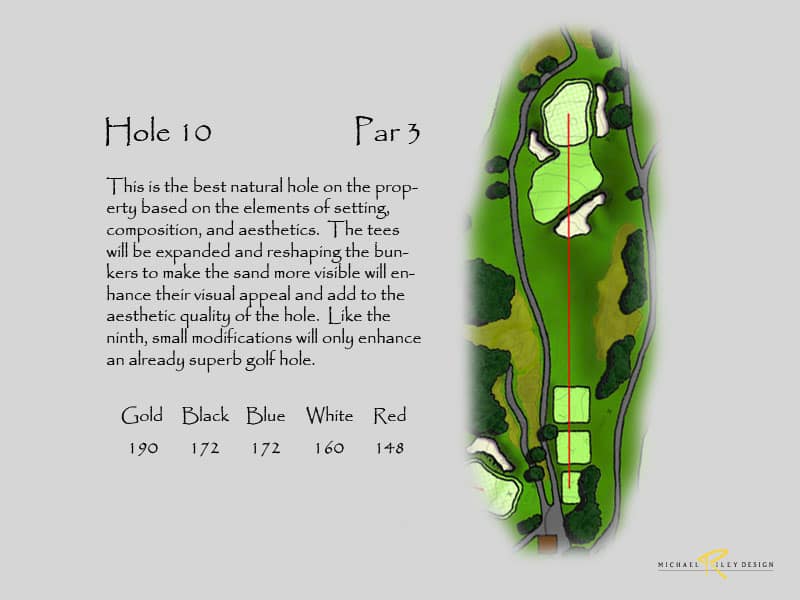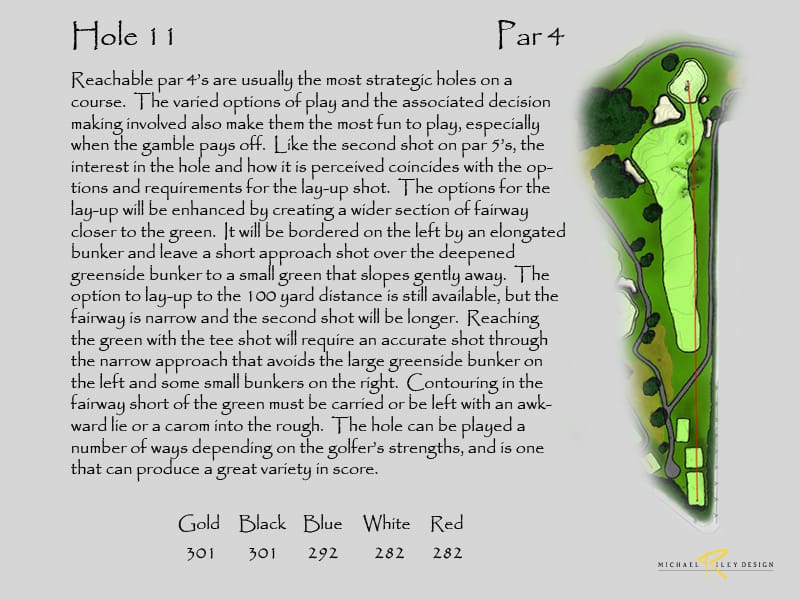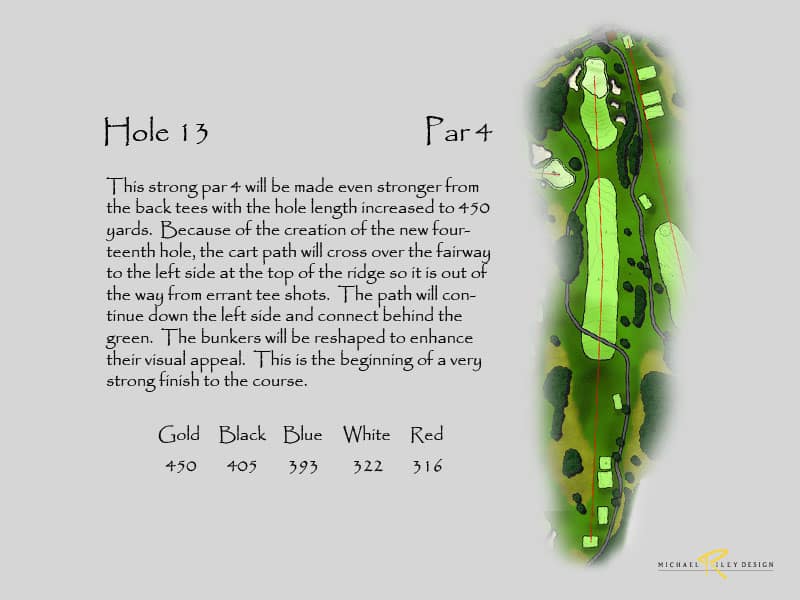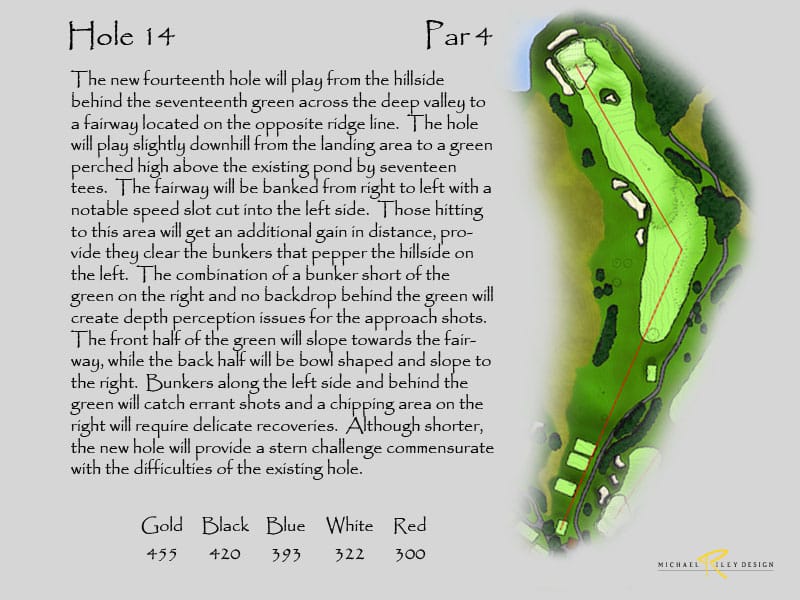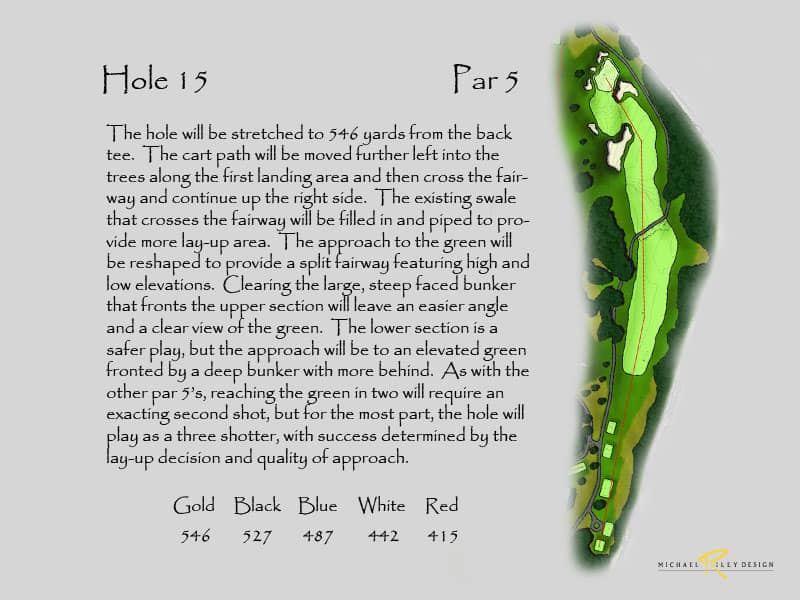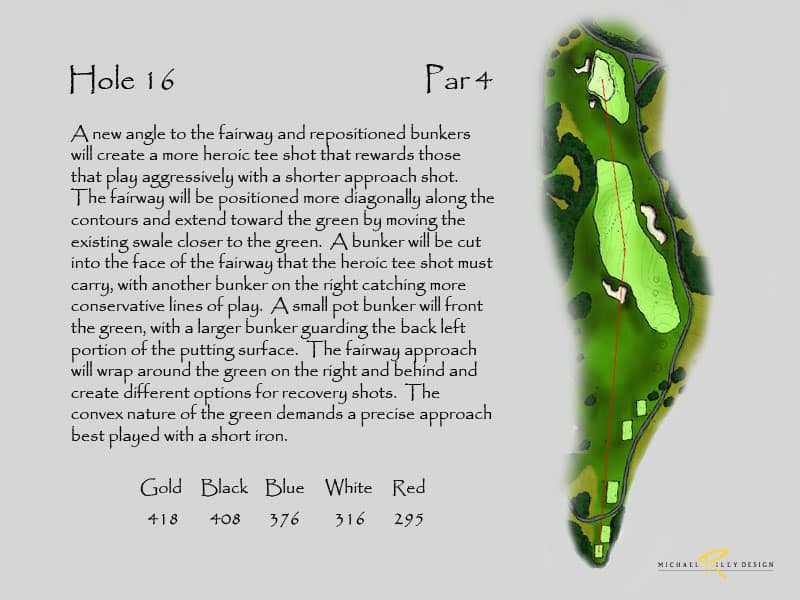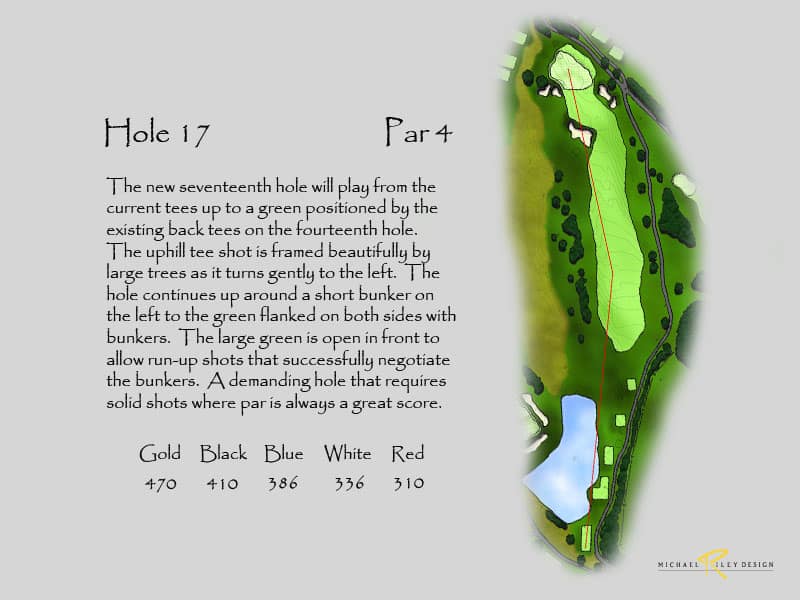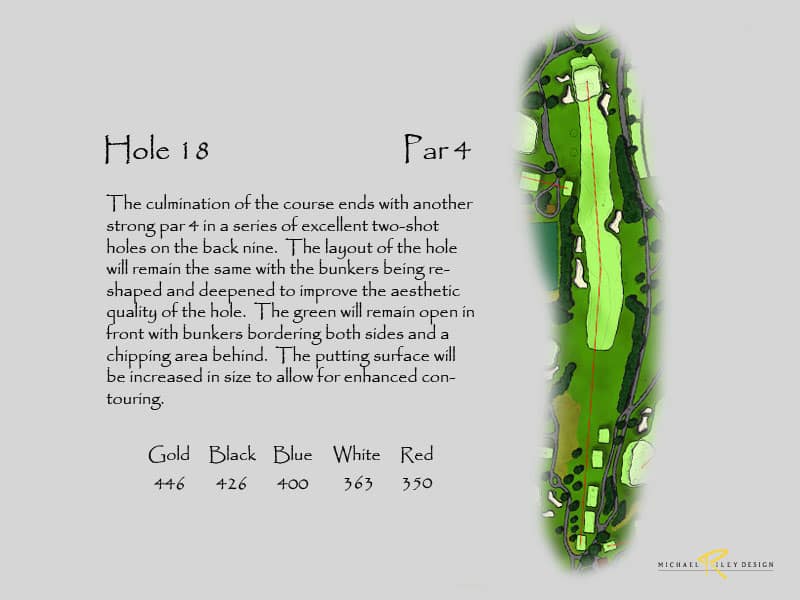EXAMPLE OF A FULL MASTERPLAN
NORWOOD HILLS MASTER PLAN
Norwood Hills Country Club has a storied history that few clubs can equal. The clubhouse was recently added to the National Register of Historical Places, and major championships have been held on the West course, most notably the 1948 PGA Championship won by Ben Hogan and recently the 2001 USGA Senior Amateur. The golf courses were designed by Wayne Stiles and established in 1922 during the Golden Age of Golf Design. While the West course enjoys a championship caliber reputation, the East course, although considerable shorter, still tests all aspects of the game. However, unlike building architecture, a golf course is alive and constantly changing, often subtly before the member’s eyes. Over a period of time, trees grow or are added narrowing the corridors of play, turf lines change, bunkers fill, and sand lines and green edges move about. And now with technology seemingly changing by the minute, courses play quite differently than envisioned decades ago. Both courses have been modified over the years by different people with mostly good results, but there are items that need to be addressed to keep improving the courses for the current membership and to attract new members for the long-term financial health of the club. A Master Plan for the club is ideal since it can address these items comprehensively. The plan would serve as a blueprint to follow in the coming years to enhance all aspects of the course and to ensure that the integrity and continuity of the design of both courses remains unified.
THE INTENT OF THE MASTER PLAN
The intent of the Master Plan is to examine all aspects of the courses and make recommendations to improve the overall quality of the golf experience. Primarily, there are three ways to define a golf course: its strategic quality, aesthetics, and turf condition – three very diverse subjects that must work well with one another to ensure a complete and unified golf experience. For example, even if a hole presents great strategic options or challenges but it is not aesthetically pleasing or if the turf is poor, the hole will often be viewed as lacking. An opinion of a good hole or bad one, or certain aspect of the course, when sifted through these criteria pinpoints the objection or praise. The answers fall in at least one of these categories. The goal is to unify each entire course from these three standpoints with recommendations being measured against classic golf design perfection.
Strategy deals with how the course plays. Strategy has also been defined as, “…the element of thought in golf… (and) that which is the soul of any great activity.” Elements that influence strategy are the slope of the land and how the holes are laid out, the positioning of the bunkers, green shapes and contours, tree locations, as well as other hazards and the like. Strategic quality is based on the sequence, variety, and sophistication of the placements of these elements and how they influence the flight, bounce, and roll of the ball by all levels of golfers. The key is to vary the strategic demands and presentations so there is no repetition, and the course does not favor a particular type of golfer or shot pattern. The result will be memorable and distinct golf holes.
Aesthetic quality deals with how the course looks. In general, aesthetic quality is the creation of character through the use of certain themes. Items such as the shaping of the strategic elements, the style of the bunkers, the scale of the open spaces, landscaping and the overall composition of these elements within the golf hole itself all determine the aesthetic quality of the course.
Finally, turf or agronomic quality is usually the result of the creation of superior growing conditions and a talented superintendent. It requires proper seedbeds, drainage, sunlight, air movement, irrigation, and the proper maintenance program.
The goal of course is to assess and blend all three of these elements (strategic, aesthetic and agronomic) into a well-balanced golf course. Strategically, balance is achieved by providing a selection of holes with bunker placements and green sizes and openings that do not favor any particular type of player. Aesthetic balance is a matter of composition, creating interesting presentations with individual personality while at the same time remaining a part of the whole. And finally, balance in conditioning relates to the consistency of the playing surfaces throughout the course, providing a uniform quality of turf.
Using this as a basis for all decision making it becomes easier to address various situations and find the most appropriate solutions. The intent herein is to put the courses in perspective with perfection and then to prescribe the most efficient improvements to that end.
THE EXISTING COURSES
A tour of both courses makes it evident why the majority of the play is on the West course. The land overall is more gentle, the routing allows for fewer blind shots and fairway contours are easier to negotiate, all of which helps the course play wider than the East. This, coupled with larger greens and a bigger scale to the course, is much preferred even though the course is substantially longer and more difficult. Having a championship pedigree plays a role too, especially with guest and outside play. The East is a much smaller and tighter course on a very sloping site, creating more uneven lies and blind shots. This makes it challenging and along with the smaller greens, is in essence the defense of the course. But technology certainly has rendered the course defenseless from a distance standpoint, and the numerous uphill blind shots, in some form on 8 of the 18 holes, is an aspect that is not usually well received. Being a more difficult walk may also be a factor. All these aspects mentioned combine to make it less appealing than the West course.
There is no easy solution to making the East course more desirable to play by making adjustments to the holes as they exist now. The limited space and nature of the land does not lend itself to producing golf holes with attributes equal to those found on the West course. In order to make the best assessment, it would be helpful to know from the membership what aspect of the course makes it less desirable. This would provide information as to where the focus should be directed. The course definitely needs to be longer in order to be perceived as challenging in today’s market. The concern would be that even after spending considerable money to make these improvements overall play does not increase sufficiently to justify this expense.
Plus, it will be difficult to add yardage with the present hole configuration. In order to make an impact, significant changes would need to be made to the routing and the grading of the site. Again, all this comes at a high cost that may still not be enough to produce the desired balance of play. This would only occur if the course was considered the equal of the West, something that will be difficult to achieve.
A couple of examples of famous 36 hole facilities may shed some light on the difficulty of elevating the status of the “second course.” At Winged Foot, the shorter East course has even held USGA Championships and some prefer it to the West, but everyone still wants to play the West since it is the US Open course and is considered better. This is also the case at Merion, where the East, which will have the US Open again in 2013, is famous and few people even know they have a West course. People play the West but certainly the preference is to play the East. Even with excellent “other” courses at these clubs, the bigger, better, more famous course is preferred. And when people say “Winged Foot” or “Merion”, the immediate thought is of the championship course. With this being people’s natural preference, it may be wise to focus the improvements and upgrades on the West course to help it withstand the amount of play it receives and to perhaps help justify increased guest fees for a much improved experience. With the information provided by the membership about the East course, a course of action for improvements can then be formulated on the existing layout to provide an enjoyable alternative.
MOTIF
Changes have occurred at the club over the years in an effort to update and improve the courses, but there still are portions of the courses that convey an old feel. Embracing the 1922 heritage motif, much like was done with the renovation of the clubhouse, should be a part of any improvements made to the courses. This is already evident with the square comers on the tees. The historic motif should be used with the bunker renovation, cart path location, fairway lines, which were very straight in that era, and green complexes, which should be void of any mounds or forms that look like they were created with a bulldozer.
As an example, establishing the motif of the original design would produce greens of great character and interest. This is proven in the early pictures of the original #2 green on the West.
The 1923 picture below shows an elongated green blending seamlessly into the setting with comers that look a little square and strategically set on an angle.
The 1934 picture below shows the green has become a round circle that has no relationship to its surrounds and looks forced on the land, and a tree has been planted in the open space behind the green closing off the views into the distance.
The strategic and aesthetic quality of the 1923 picture is much more interesting because of the composition of all of the elements. It is with this in mind that I feel the historic nature and integrity of the original design motif be incorporated into any alterations on the courses.
BUNKERS
A motif will be identified and implemented to improve the aesthetics of the bunkers and help unify their appearance. This does not suggest that every bunker should look like every other bunker, but that they assume shapes within a general pattern. Their size, location and depth will give them independent personalities. One aspect that would make an immediate impact is to lower the entries into the bunkers. Right now, the entries are quite high in places and block the views into the bunkers. If the elevations around the bunkers are uniform, it makes them “bathtub like” in appearance and also makes them look like they are sitting on top of the ground instead of being cut into the ground.
The West course has some large bunkers throughout the course, but only small portions are visible from the tees or landing areas, which makes them appear out of scale and defeats their importance in terms of strategy, aesthetics and visual impact. The sand lines should be adjusted to create more dramatic bunkers that are strong in character and add to the composition of the holes. All of the top courses have great bunkering that is distinctive, and this can and should be the case here. Also, some of the mounding around the bunkers should be eliminated. The left fairway bunkers on 1 8 are a good example of this. The outside mounds are too uniform in appearance and produce a very manufactured look. The outside edge should be lower and blended naturally to the surrounding areas. If the East course is renovated to a great extent to be more like the West course, then the bunker motif should be the same for both courses, since they were originally designed and built at the same time, much like the courses at Winged Foot. If the East course stays as is, then an alternative bunker motif may be considered to coincide with the style of the course, and to differentiate it from the West course.
The following pictures of the 10th hole show the existing bunkers in their current state and one showing how lowering the entries and seeing more sand can impact the aesthetic quality and composition of the hole. This is just an example using a different style of bunker motif for this illustration. There are other motifs, whether they are grass down on the slopes with low sand or bunkers with the sand flashed up and more visible. Of course, the final selection of any motif should consider the historical era in which Norwood Hills was founded as well as the impact of weather and any other maintenance issues.
Existing
Proposed
TEES
Many of the tees are too small or unlevel, so recommendations are made for increased length and where tees need to be enlarged to handle the amount of play. A prime example of this is the tee complex on the first hole of the West course. There is plenty of room to increase the size of the blue tee by regrading the area. The forward tees also need to be enlarged since there is really only one tee placement in the middle, and more damage is being done to the tees by the turning of the mowers than by the golfers. The motif should continue to be the square corners like the tees Mike Null has recently redone and others on the course. The straight lines produce a very detailed look and fit the 1922 heritage of the courses.
ln other cases, for instance on hole #7, the location of the tees need to be rearranged. Currently the cart path runs down the middle of the complex with multiple tees on each side. This arrangement, coupled with the placement of the ball washer and hole sign/garbage can, interrupts the foreground composition and greatly detracts from the overall aesthetics of the hole. The tees should be located so that the back tee is to the right and the other tees stagger to the left as they move forward. The cart path would be located along the left side of the tees and then cross back over underneath the complex in the valley and out of view. The ball washer and hole sign/garbage can could then be located along the path and subsequently also out of view. This will greatly improve the aesthetic quality of the hole, as well as strategically since the hardest angle is from the right and the green opens up more as the tees move left.
GREENS
The putting surfaces varied from those with interesting contours to others with very little contour. The new green at #6 would fall into the former category and the bold contours are more fitting with a course of this era. The green speeds where very slow then so the surf aces tended to be more bold to produce interesting putting. Greens have gotten flatter over the years as the grass varieties have improved and speeds have gotten f aster. This has also produced greens that are quite simplistic in their design and strategic quality, and quite frankly, are dull and forgettable. Mike Null’s findings of the original cinder layer and the dimensions of the greens is very interesting and is evidence of how much the greens have shrunk in size over the years. They appear to have been much bigger in places, extending up onto the mounds and down into the lows. This would have produced greens with very interesting shapes and dramatic contours, which would have been fitting for the time frame when they were built and very unique today. Reestablishing this type of design and look for the greens warrants discussion, whether it is the expansion of the current greens or implemented during a renovation of the green complexes in the future.
CARTPATHS
Cart paths have become a fixture on virtually all courses today, except for rare instances where only caddies exist. Their existence, although unsightly, helps produce better turf conditions by providing a solid surface for carts and maintenance vehicles to travel on, especially in high traffic areas and during unusual weather patterns. Their location is always a dilemma, since they need to be far enough to be “out of play” while still being close enough to reduce long walks. There are places on the course where the cart paths should be relocated further away from the playing areas and out of view. This will greatly enhance the aesthetic quality of the holes, an aspect all the great courses without paths enjoy. One example of this would be on #6, where the path location from the red tees up to the bunker greatly detracts from the hole and the natural setting in the valley. The path should be moved to the right around the large evergreen tree and shaped to be hidden from view as it ties back in by the bunker.
SELECTIVE TREE REMOVAL
The recently initiated tree removal program has improved the quality of each hole and should continue. Removing trees always is controversial but eliminating them has the greatest impact on improving turf and playing conditions. Shade from trees produces weak turf and soft conditions, a continuing and only worsening problem as trees grow and mature. The course has an abundance of trees so continuing to remove select trees to create more sun and air movement for healthier turf will not affect the course adversely. This has been the trend in recent years at courses such as Winged Foot, Shinnecock Hills, and Oakmont where they eliminated all the trees, as well as many other clubs.
Initially there were uproars about removing the trees, but after completed, the
members realized the improved conditioning and appreciated the open spaces. Trees surrounding a golf hole become a repetitive dark green backdrop of little interest. A backdrop of a single specimen tree or a group of trees with open space around them is far more interesting and noticeable. Opening up views into other holes and across the property brings a grander scale to the course. This is evident on #6, where the single trees and groups of trees are perfectly blended with the open space to create a wonderful composition to the hole. Another example is the large specimen tree behind #8 green that now serves as a focal point, instead of being just another large tree in a mass of trees.
DRIVING RANGE EXPANSION
ln order to lengthen the range in its present location, the 14th hole would need to be relocated so the second half of the hole, where the danger exists from balls from the range, can become part of the range expansion. A new 14th hole could be built on the land between the 13th and 17th holes. The tee would be located next to the 13th green and play over the current 17th green to the ridgeline and then dogleg slightly left to a green situated above the current pond on 17. The hole would measure approximately 450 yards. A new 17th hole would also ne ed to be constructed, playing from the existing tees across the pond on a line towards the beginning of the existing 14th fairway. The hole would turn lightly left to the green which would sit where the tees on 14 now exist. The hole would measure approximately 470 yards, with most of the m being uphill. This would allow the range to be 300 yards, which is me assured from the middle of the back tees to the greenside bunker on the existing 14th green.
Netting at the back of the range would still be needed to keeping bounding balls from entering the new 17th hole. Additional landscaping would be suggested to screen the netting and also provide more separation from the driving range. This configuration would produce two outstanding holes. Currently, holes 16 and 17 are the same length on the card and are very short with today’s technology, so changing 17 would produce a much stronger finish. And, the new holes add 30 yards to the overall length.
However, the cost involved to make this adjustment and expand the driving range to the new length must be a consideration. As a comparison, if space was available on the property to build a new driving range, the costs would be similar since the range is typically considered the equivalent in size of two golf holes. If the existing holes remain intact and the range is not expanded, the other solutions would be to raise the netting high enough to keep balls out of #14 entirely and/or go to a limited flight ball. With distance increases seemingly occurring with every new driver released on the market, the netting although unsightly, has become more commonplace with places even like Augusta National, Oak Hill, and Winged Foot using it to keep balls within the confines of their practice areas.
ADDITIONAL LENGTH
There are places throughout the West course to lengthen the holes to achieve a total length over 7,000 yards. At first glance, holes that could be lengthened are #9, #12, #13, #15, and #16. If the 14th and l7th holes are relocated, their new combined lengths would increase the overall length by 30 yards. As mentioned before, adding any significant length to the East course is a difficult proposition based on the present configuration.
SUMMARY
The recommended alterations to the course will greatly enhance the golf experience by improving the overall aesthetic quality and strategic options on the golf holes, and with expanded playing surf aces, the quality of the conditioning. The course is deserving of the most thoughtful care. And based on the history, it is not a stretch to say it is an American treasure. But like all courses there are some very real needs that could and should be addressed within a reasonable budget. The primary focus is the employment of the membership and the total quality of the golf course. Without question, all work must provide forms that appear homogenous and reasonably historic, and will continue to raise the level of excellence at Norwood Hills.





